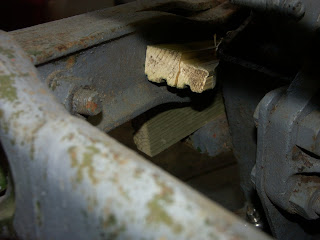
This leak indicating that either the crankshaft rear seal and or the gearbox input shaft seal needed replacing.
As I don't have access to an engine hoist, I decided that I would leave the engine attached to the front axle and once split from the gearbox 'wheel' the engine forward using the front wheels and a trolley jack under the sump for support.
As the engine weights approximately 150 lbs and the thought of it dropping on my toes wasn't part of my plan. I took the precaution of using a ratchet strap around the engine and trolley jack to ensure the engine remained centred on the jack and wedging the engine against the front axle using wooden wedges to prevent the engine 'spinning' once disconnected from the gearbox (see photo below).

Having removed both track rods this left both the front wheels free to turn independently. Fearing this would cause a problem when moving the engine I took the additional precaution of attaching a piece of timber between the front ball joint mountings in order to ensure both wheels would remain parallel to each other. The timber can just be seen in the next photo at the front of the engine. Finally both radius arms were released from there gearbox mountings and splayed outwards slightly to clear the bell housing.
With all the engine/gearbox bolts removed but for two, I was ready to proceed. Slackening both bolts so that I had about a 10mm gap between the bolt head and the engine. I then called on the trusty foot of Geoff to push the clutch pedal down in order to 'break' the engine and gearbox joint.
The big moment ! unfortunately, nothing happened. A second go, still no luck. "Perhaps if we depress the clutch pedal instead of the brake ?" offered Geoff.

Two seconds later, and pressing the correct pedal this time, resulted in a satisfying 'Pop' as the engine moved away from the gearbox by 10mm . Totally removing both bolts and the engine was now free to be moved forward as seen in the photo opposite. The red ratchet strap around the engine and jack can also be seen in this photo.
Success a split engine and gearbox ! and surprisingly secure.
With the two parts now separated I could examine the clutch and investigate the oil leak.  My first observations was of a worn thrust bearing and also badly worn fingers on the clutch pressure plate. In the photo to the left you can see where the front surface of the top finger has completely worn through !
My first observations was of a worn thrust bearing and also badly worn fingers on the clutch pressure plate. In the photo to the left you can see where the front surface of the top finger has completely worn through !
The the pressure plate will therefore need replacing and a new friction plate. 150 quid of unwanted expense.
Now to identify the oil leak, having remove the clutch and flywheel there is plenty of oil on the engine casing. New seal definitely needed. Interestingly, the bottom crankshaft seal retaining plate has a bolt missing (see photo below). Further evidence of previous 'tamperings'
The pilot bearing in the flywheel is also knacked so I'm looking at the following parts;
Crankshaft seal, pilot bearing, flywheel locking plates, friction plate, pressure plate, thrust bearing and a gearbox input shaft seal.
Enough excitement for one day !



